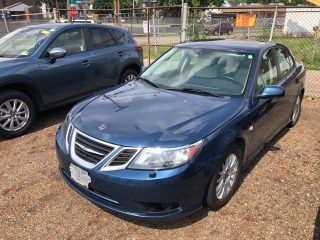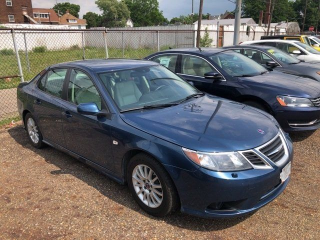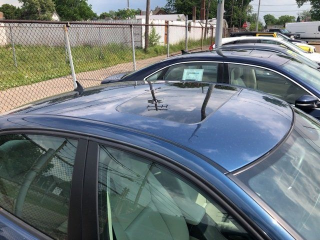The 2010 Saab 9-3, part of a model run from 2003 to 2011, is a Swedish-designed compact executive car known for its unique styling and engaging driving dynamics. Available as a sedan, hatchback (SportCombi), and convertible, key trims included the Vector and Aero. Originally priced from around $28,000 to $40,000, it stood out with its aviation-inspired cockpit, turbocharged performance, and a cult following valuing its distinct character over mainstream appeal.
The Good
The 2010 Saab 9-3 offers a compelling blend of spirited turbocharged performance, comfortable ride, and distinctive Scandinavian design. Its practical hatchback option and engaging handling appeal to driving enthusiasts, while surprisingly good fuel economy for its class and solid build quality offer practical benefits.
The Bad
Potential buyers should be aware of possible electrical gremlins, particularly with the infotainment system and climate control. Some owners report issues with turbocharger components and suspension wear. Parts availability can also be a concern due to Saab's production status.
2010 Saab 9-3: Quick Overview
- Engine Options: The 2010 Saab 9-3 primarily featured turbocharged 4-cylinder engines. The standard engine was a 2.0-liter turbocharged inline-4.
- Horsepower: Base models typically produced around 210 horsepower. Higher performance trims, like the Aero, could have variants with slightly more power, potentially reaching up to 235 horsepower in some configurations.
- Fuel Economy: Fuel economy varied depending on the engine and transmission. For the 2.0-liter turbocharged engine with a manual transmission, expect an EPA estimated rating of around 20 MPG city and 30 MPG highway. Automatic transmissions might see slightly lower figures.
- 0-60 Times: Acceleration figures generally ranged from approximately 6.7 to 7.5 seconds for the 2.0T models, depending on the specific configuration and driver. Performance-oriented trims like the Aero could achieve slightly quicker times.
- Towing Capacity: The Saab 9-3 was not typically designed for towing. It does not have an official towing capacity rating.
- Trim-Level Features:
- Linear: Often the base trim, it included essentials like power windows and locks, air conditioning, cruise control, and an AM/FM/CD audio system.
- Vector: This mid-level trim added more premium features such as leather upholstery, upgraded wheels, a sport-tuned suspension, and enhanced interior trim.
- Aero: The top-tier trim, the Aero, offered the most powerful engine option, sportier exterior styling cues, larger alloy wheels, advanced audio systems, and often included premium comfort and convenience features like heated seats and a sunroof. Some models might have featured more aggressive body kits and unique badging.
2010 Saab 9-3 Specifications
Vehicle Information
| Year | 2010 |
| Make | Saab |
| Model | 9-3 |
| Trim | - |
| Style | Front-Wheel Drive 2.0-T |
| Type | Wagon |
| Category | Subcompact Car |
Manufacturing Details
| Made In | Sweden |
| Manufacturing City | TROLLHATTAN |
Dimensions
| Doors | 4-Door |
| Curb Weight | 3285 pounds |
| Gross Vehicle Weight Rating | - |
| Overall Height | 58.90 inches |
| Overall Length | 183.90 inches |
| Overall Width | 70.90 inches |
| Wheelbase Length | 105.30 inches |
| Standard Seating | 5 |
Engine & Performance
| Engine | 2.0-L L-4 DOHC 16V Turbo |
| Engine Size | 2L |
| Engine Cylinders | 4 |
| Transmission | 6-Speed Automatic |
| Transmission Type | Automatic |
| Transmission Speeds | 6-Speed |
| Drivetrain | Front-Wheel Drive |
Additional Features
| Anti-Brake System | 4-Wheel ABS |
| Steering Type | Rack & Pinion |
Pricing
| Manufacturer Suggested Retail Price (MSRP) | $30,330 |
| Invoice Price | $29,268 |
| Delivery Charges | $825 |
Vehicle History Report
Vehicle
Specifications
Specifications
Ownership
History
History
All History
Events
Events
NMVTIS Title
History Check
History Check
Salvage/Rebuilt
Check
Check
Accident
Check
Check
Theft
Check
Check
Open Lien
Check
Check
Past Sale
Listings
Listings
Safety
Recalls
Recalls
Odometer
Check
Check
Market Price
Analysis
Analysis
What Problems Does the 2010 Saab 9-3 Have?
The 2010 Saab 9-3, while generally considered a decent performer, does have some commonly reported issues that potential buyers should be aware of. Electrical problems are a frequent concern. This can manifest as issues with the infotainment system, including malfunctioning radios and displays, as well as problems with the climate control system, such as the blower motor or AC not working correctly. The instrument cluster can also be a source of trouble.
On the mechanical front, some owners have reported issues related to the turbocharger system, including oil leaks or premature failure. The ignition coil system is also a known weak point, often leading to misfires and rough running. Suspension components, such as bushings and shock absorbers, may also wear out faster than on some competitors. Some reports indicate a tendency for the ABS (Anti-lock Braking System) module to fail over time.
While specific model year recalls for the 2010 9-3 were not as extensive as for some other vehicles, it's crucial to check the National Highway Traffic Safety Administration (NHTSA) website for any outstanding recalls applicable to the specific vehicle you are considering. Long-term reliability can be impacted by the availability and cost of replacement parts, as Saab as a brand no longer exists. While many parts are shared with other GM platforms, specialized Saab components can be harder to find and more expensive. Consistent and proactive maintenance is key to mitigating many of these potential issues and ensuring a longer service life for the vehicle.
How long will the 2010 Saab 9-3 last?
Based on owner data and typical maintenance practices, a well-maintained 2010 Saab 9-3 can reasonably be expected to last between 150,000 to 200,000 miles. Some owners have reported significantly higher mileage, pushing past 250,000 miles with diligent care. Long-term durability is heavily influenced by addressing known issues promptly, particularly electrical gremlins and turbocharger maintenance. Neglect in these areas can lead to more significant and costly repairs. The chassis and powertrain are generally robust, but wear and tear on suspension components and the potential for electrical system failures are weaknesses that emerge over time. Regular fluid changes and prompt attention to warning lights are crucial for maximizing its lifespan.
What Technology & Safety Features are Included?
The 2010 Saab 9-3 offered a suite of technology and safety features that were competitive for its era. Standard tech often included an AM/FM/CD audio system, with optional upgrades to a more advanced system featuring Bluetooth connectivity for hands-free calling and audio streaming. Satellite radio was also an available option. The dashboard was designed with an aviation-inspired cockpit layout, featuring clear instrumentation and logically placed controls, which was a signature Saab design element.
Driver-assistance features were more limited by modern standards but typically included standard cruise control. Anti-lock brakes (ABS) and traction control were standard safety features, crucial for maintaining stability in various driving conditions.
Safety was a priority for Saab. The 2010 9-3 came equipped with a comprehensive set of airbags, including front-seat side-impact airbags and full-length side curtain airbags for sedan and SportCombi models. The convertible featured reinforced A-pillars and pop-up rollover protection bars. The vehicle's structure was designed to absorb and dissipate impact energy.
Regarding crash-test ratings, the 2010 Saab 9-3 generally performed well in tests conducted by the Insurance Institute for Highway Safety (IIHS) and the National Highway Traffic Safety Administration (NHTSA). While specific ratings can vary slightly by test and year, it typically received good marks for front and side-impact crashworthiness. For instance, IIHS awarded it with "Good" ratings in many categories, highlighting its structural integrity and occupant protection. These strong safety ratings contributed to its appeal as a secure vehicle.
What Colors Options are Available?
2010 Saab 9-3 Prices and Market Value
When new, the 2010 Saab 9-3 had an original MSRP ranging from approximately $28,000 for base models to over $40,000 for higher trims and the convertible. Like most vehicles, it experienced significant depreciation in its early years. Currently, used 2010 Saab 9-3 models typically range from $4,000 to $9,000, depending heavily on mileage, condition, trim level (Aero and convertible models often fetch higher prices), and maintenance history. Factors affecting its resale value include the declining availability of specialized parts and the perception of Saab as a defunct brand, which limits its appeal to a wider market. However, for enthusiasts who appreciate its unique qualities, well-maintained examples can still command a reasonable price. Its depreciation has largely stabilized in the used market, making it a potentially good value for the right buyer.
2010 Saab 9-3 Cost of Ownership
Owning a 2010 Saab 9-3 can be moderately economical if well-maintained, but repairs can be costly. Insurance rates are generally average for a compact executive car. Fuel costs are reasonable, with turbocharged engines offering decent MPG. Maintenance requires diligent attention, especially to potential electrical and turbo issues; expect costs to be slightly above average due to specialized parts and fewer independent mechanics familiar with the brand. Repair costs can be higher when specific Saab components are needed. Overall, while not prohibitively expensive, it leans towards being more costly to own than a mainstream Japanese or American sedan, particularly if unforeseen repairs arise.
2010 Saab 9-3 Fuel Efficiency
Fuel Type
Gasoline
Fuel Capacity
16.00 gallons
City Mileage
19 miles/gallon
Highway Mileage
27 miles/gallon
2010 Saab 9-3 Safety Rating
NHTSA
IIHS
2010 Saab 9-3 Recalls & Defects
Fuel System, Other:delivery:fuel Pump
Recall date
2011-01-19
Recall no.
11v015000
Source
NHTSA
Summary
Saab IS Recalling Certain Model Year 2010 and 2011 Passenger Vehicles Manufactured From June 2010 Through December 2010. Certain Fuel Pumps Installed AS Original Equipment MAY Have Internal Components With Incorrect Specifications.
Consequence
THE Subject Fuel Pumps CAN Seize Causing THE Engine TO Stall Which Increases THE Risk OF A Crash.
Remedy
Saab Will Notify Owners and Replace THE Defective Fuel Pumps Free OF Charge. THE Safety Recall Began ON March 3, 2011. Owners MAY Contact Saab AT 1-800-955-9007.
Notes
Saab's Recall Campaign Number IS 15029.owners MAY Also Contact THE National Highway Traffic Safety Administration's Vehicle Safety Hotline AT 1-888-327-4236 (Tty 1-800-424-9153), or GO TO <A Href=http://Www.safercar.gov>http://www.safercar.gov</a> .
Fuel System, Gasoline:delivery:fuel Pump
Recall date
2011-02-28
Recall no.
11e009000
Source
NHTSA
Summary
TI Automotive IS Recalling Certain Fuel Pumps, Part Numbers Tu456 and Tu303, Sold Under Various Brand Names AS Aftermarket and Replacement Equipment FOR THE Motor Vehicles Listed Above. THE Defective Fuel Pump MAY Seize, Stopping THE Fuel Flow TO THE Engine Creating A Stalling Condition.
Consequence
A Vehicle Crash Could Occur Should THE Engine Stall While IN Use.
Remedy
TI Automotive Will Notify Owners OF Record and Will Replace ANY Defective Fuel Pump With A NEW or Reworked Fuel Pump Free OF Charge. THE Safety Recall Began ON February 22, 2011. Owners MAY Contact TI Automotive AT 1-866-867-3759 or LOG ON TO Www.recallresponse.com.
Notes
This Recall Only Pertains TO Aftermarket and Replacement Fuel Pumps and HAS NO Relation TO ANY Original Equipment Installed ON Vehicles Manufactured BY General Motors.owners MAY Also Contact THE National Highway Traffic Safety Administration's Vehicle Safety Hotline AT 1-888-327-4236 (Tty 1-800-424-9153), or GO TO <A Href=http://Www.safercar.gov>http://www.safercar.gov</a> .
Seat Belts:front:retractor
Recall date
2014-06-12
Recall no.
14v318000
Source
NHTSA
Summary
General Motors LLC (Gm) IS Recalling Certain Model Year 2004-2011 Saab 9-3 Convertible Vehicles Manufactured July 30, 2003, TO February 15, 2011. IN THE Affected Vehicles, THE Driver's Side Front Seat Belt Retractor MAY Break, Causing THE Seat Belt Webbing NOT TO Retract.
Consequence
IN THE Event OF A Crash, A Seat Belt That HAS NOT Retracted MAY NOT Properly Restrain THE Seat Occupant, Increasing Their Risk OF Injury.
Remedy
GM Will Notify Owners, and Dealers Will Replace THE Driver's Seat Belt Retractor, Free OF Charge. THE Recall Began ON October 6, 2015. Owners MAY Contact Saab Customer Service AT 1-800-955-9007. Gm's Number FOR This Recall IS 14222. Note: Special Coverage 10086 Will Replace THE Passenger Side Seat Belt Retractor IF IT Fails, Free OF Charge, FOR THE Life OF THE Vehicle.
Notes
Owners MAY Also Contact THE National Highway Traffic Safety Administration Vehicle Safety Hotline AT 1-888-327-4236 (Tty 1-800-424-9153), or GO TO Www.safercar.gov.
AIR Bags:frontal:driver Side:inflator Module
Recall date
2016-02-03
Recall no.
16v063000
Source
NHTSA
Summary
General Motors LLC (Gm) IS Recalling Certain Model Year 2006-2011 Saab 9-3 Vehicles Manufactured MAY 31, 2002, TO February 15, 2011, 2006-2009 Saab 9-5 Vehicles Manufactured June 7, 2005, TO MAY 28, 2009, and 2008-2009 Saturn Astra Vehicles Manufactured April 11, 2007, TO July 24, 2008. Upon Deployment OF THE Driver's Frontal AIR Bag, Excessive Internal Pressure MAY Cause THE Inflator TO Rupture.
Consequence
IN THE Event OF A Crash Necessitating Deployment OF THE Driver's Frontal AIR Bag, THE Inflator Could Rupture With Metal Fragments Striking THE Driver or Other Occupants Resulting IN Serious Injury or Death.
Remedy
GM Will Notify Owners, and Dealers Will Replace THE Driver's Frontal AIR BAG Inflator ON Saab 9-3 and 9-5 Vehicles and Will Replace THE Driver's Frontal Airbag Module ON Saturn Astra Vehicles, Free OF Charge. THE Recall Began ON March 1, 2017. Owners MAY Contact Saab Customer Service AT 1-800-955-9007 or Saturn Customer Service AT 1-800-553-6000. Gm's Number FOR This Recall IS 28810.
Notes
Owners MAY Also Contact THE National Highway Traffic Safety Administration Vehicle Safety Hotline AT 1-888-327-4236 (Tty 1-800-424-9153), or GO TO Www.safercar.gov.
2010 Saab 9-3 Warranty
Basic
Original warranty
48 months / 50,000 miles
Estimated remaining
Expired
Powertrain
Original warranty
48 months / 50,000 miles
Estimated remaining
Expired
Rust
Original warranty
120 months / unlimited miles
Estimated remaining
Expired
2010 Saab 9-3 Insurance
Insurance for a 2010 Saab 9-3 is moderately priced, reflecting its status as a Wagon with strong safety ratings and
reasonable repair costs.
reasonable repair costs.
How Does the 2010 Saab 9-3 Compare to Other Wagon?
The 2010 Saab 9-3 competed in the compact executive segment against strong rivals like the BMW 3 Series, Audi A4, and Mercedes-Benz C-Class. In terms of performance, the Saab's turbocharged engines offered a unique, engaging driving experience with a focus on torque steer and agile handling, often rivaling the sportiness of the BMW 3 Series, though perhaps lacking the refined sophistication of the German trio.
Feature-wise, the 9-3 offered a comfortable and well-appointed interior with a distinct "cockpit" feel, but its technology and infotainment systems were generally less advanced and user-friendly compared to its German counterparts, which often boasted more intuitive interfaces and a wider array of cutting-edge tech.
Reliability is where the Saab 9-3 can be a mixed bag. While the core mechanicals are generally robust, the electrical systems and specific Saab components can be more prone to issues than the highly reliable Japanese competitors like the Lexus IS. The German rivals also have a reputation for higher maintenance costs, but parts availability for the Saab is now a significant concern due to the brand's demise, potentially making repairs more challenging and expensive than for its established competitors.
In terms of price, the Saab 9-3 offered a compelling value proposition when new, often undercutting its German rivals. On the used market, it remains significantly cheaper than comparable BMWs or Audis, making it an attractive option for budget-conscious buyers seeking a unique and sporty car.
Alternatives: If reliability and ease of maintenance are paramount, a Lexus IS 250 or an Infiniti G37 would be more practical choices. For a similar blend of sportiness and luxury at a higher price point, a BMW 328i or Audi A4 would be worth considering. If budget is the primary driver and a unique European feel is desired, the Saab 9-3 remains a compelling, albeit more niche, option. However, if readily available parts and widespread service network are crucial, other brands might be a safer bet.
Final Verdict: Is the 2010 Saab 9-3 a Good Wagon?
The 2010 Saab 9-3 is ideal for the discerning enthusiast who values distinctive design, engaging turbocharged performance, and a comfortable ride over mainstream appeal. It's a car for those who appreciate its unique Scandinavian heritage and are willing to be part of a niche community. It is worth buying, but with significant caveats, especially in the current used market.
It's best purchased as a used vehicle, as new models are long gone. Buyers should focus on well-maintained examples, ideally with comprehensive service records. Specific trims like the Aero offer a more engaging driving experience, while the SportCombi provides practicality. Convertible models appeal to those seeking open-air motoring. Prospective owners must be aware of the potential for higher maintenance and repair costs due to parts availability and be comfortable with a less common vehicle. It's a purchase for the head and the heart, but the head must acknowledge the pragmatic challenges.



